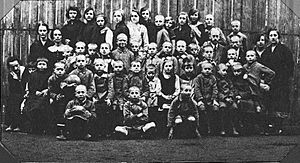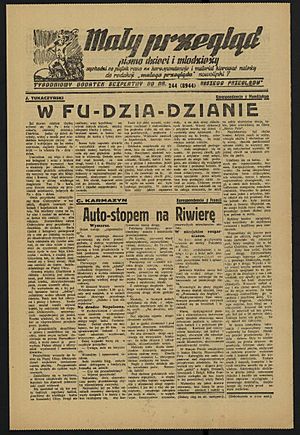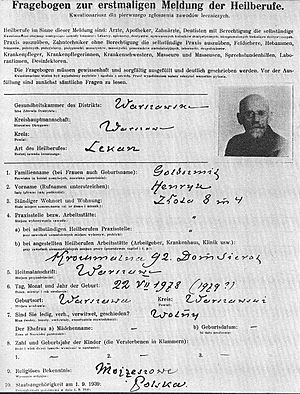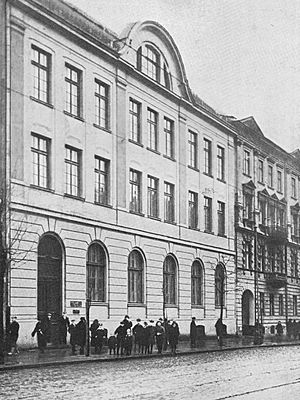Janusz Korczak facts for kids
Quick facts for kids
Janusz Korczak
|
|
|---|---|
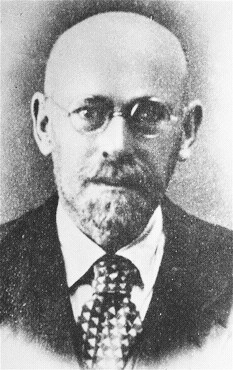
Janusz Korczak, photographed c. 1930
|
|
| Born |
Henryk Goldszmit
22 July 1878 Warsaw, Congress Poland, Russian Empire
|
| Died | c. 7 August 1942 (aged 64) Treblinka extermination camp, German-occupied Poland
|
| Nationality | Polish |
| Occupation | Children's author, humanitarian, pediatrician, child pedagogue and defender of children's rights |
Janusz Korczak (born Henryk Goldszmit, July 22, 1878 or 1879 – August 7, 1942) was a special Polish Jewish educator and writer. He was known as Pan Doktor ("Mr. Doctor") or Stary Doktor ("Old Doctor"). He spent many years leading an orphanage in Warsaw.
When the children from his orphanage were sent to the Treblinka extermination camp during World War II, he refused to leave them. He chose to stay with his orphans, even though he was offered safety. This happened during the Grossaktion Warschau in 1942.
About Janusz Korczak
Korczak was born in Warsaw in 1878. He wasn't sure of his exact birth date. His father, Józef Goldszmit, was a respected lawyer. His mother was Cecylia Gębicka. He grew up in a Jewish family. Later in life, he didn't believe in forcing religion on children.
When he was about 12, his father became ill. His family's money situation got worse. Henryk started working as a tutor for other students while still in school. In 1896, he wrote his first story, Węzeł gordyjski, which was about raising children.
In 1898, he started using the name Janusz Korczak for a writing contest. He got the name from a book by Józef Ignacy Kraszewski. From 1898 to 1904, Korczak studied medicine at the University of Warsaw. He also wrote for Polish newspapers. After finishing his studies, he became a pediatrician, a doctor for children.
From 1905 to 1912, Korczak worked at the Bersohn and Bauman Children's Hospital in Warsaw. He also served as a military doctor during the Russo-Japanese War (1905–06). His book Child of the Drawing Room made him a well-known writer.
In 1909, he met Stefania Wilczyńska, who became his closest helper. In 1911–1912, he became the director of Dom Sierot (Orphan House) in Warsaw. This was an orphanage he helped design for Jewish children. He hired Stefania as his assistant.
At the orphanage, he created a special "republic" for the children. They had their own small parliament, a court, and even a newspaper. He spent less time as a doctor to focus on the orphanage.
During World War I (1914), Korczak was a military doctor. He also served in the Polish Army during the Polish–Soviet War. After the wars, he continued his work in Warsaw. Korczak never married and had no children of his own.
Life in Poland
In 1926, Korczak helped the children of Dom Sierot start their own newspaper. It was called Mały Przegląd (Little Review). It was a weekly part of a Polish-Jewish newspaper. His orphanage received support from the CENTOS Polish-Jewish charity.
In the 1930s, Korczak had his own radio show. He used it to talk about and support the rights of children. In 1933, he received an award called the Silver Cross of the Polonia Restituta.
Between 1934 and 1936, Korczak visited Mandate Palestine each year. He saw the kibbutzim, which are special communities. He thought about moving there, but he felt he couldn't leave his children behind. He stayed in Poland, even when Stefania Wilczyńska moved to Palestine in 1938.
During the Holocaust
When World War II began in 1939, Korczak tried to join the Polish Army, but he was too old. He saw the German army take over Warsaw. In 1940, the Germans created the Warsaw Ghetto. Korczak's orphanage had to move into the Ghetto. He moved with the children. In July, he decided the children should perform a play called The Post Office.
On August 5 or 6, 1942, German soldiers came to take the 192 orphans and about a dozen staff members. They were to be sent to the Treblinka extermination camp. Korczak was offered a chance to escape by a Polish underground group. But he refused many times. He said he could not leave his children. He believed, "You do not leave a sick child in the night, and you do not leave children at a time like this."
The children wore their best clothes. Each carried a blue backpack and a favorite book or toy.
Witnesses said that when they reached the Umschlagplatz (a collection point), an SS officer recognized Korczak. The officer offered to help him escape. Korczak refused again. He got on the train with the children. He was never seen again.
It is believed that Korczak, Stefania Wilczyńska, and most of the children were killed in a gas chamber at Treblinka.
Korczak's Writings
Korczak's most famous writings are his stories and books about education. Many of his popular works have been translated into other languages. His main books on teaching have been translated into English. As of 2012, two of his novels were in English: King Matt the First and Kaytek the Wizard.
The exact date of Korczak's death was not known for a long time. In 1954, a Polish court set his death date as May 9, 1946. This was a common ruling for people who died during World War II without a clear date. Later, in 2015, a court ruled that he died in 1942. This meant his works could be freely used by the public.
Korczak wrote from 1896 until August 8, 1942. He wrote over twenty books, more than 1,400 articles, and many essays. He wrote for both children and adults.
Children's Books
Korczak often used fairy tales to help young readers. He wanted to prepare them for the challenges of adult life. He taught them about making responsible choices.
In his 1923 book King Matt the First (Król Maciuś Pierwszy), he tells the story of a child prince. Matt becomes king suddenly after his father dies. He learns from his mistakes:
- He tries to answer all his mail himself but realizes he needs helpers.
- He arrests his ministers but learns he can't rule alone.
- During a war, he secretly joins the army as a peasant boy.
- He starts a "royal paper" but finds out the news is edited.
- He tries to unite children worldwide to demand their rights.
- He falls in love with an African princess, which causes problems.
- In the end, he is overthrown and sent to a desert island. There, he learns to accept reality.
Another book, Kajtuś the Wizard (Kajtuś czarodziej) (1933), was translated into English in 2012. This book is about a schoolboy who gains magic powers. It was very popular in the 1930s. Unlike Harry Potter, Kajtuś has to learn to use and control his powers all by himself. He also learns about his limitations.
Korczak's book The Persistent Boy was a biography of the French scientist Louis Pasteur. It was written for children. Korczak wanted Pasteur to be a role model. The book shows how Pasteur, despite a humble start, achieved great things through hard work and persistence.
Pedagogical Books
In his books about teaching, Korczak shared his experiences. He wrote about how to work with children, especially those who were difficult. Other educators, like Simon Soloveychik, later built on Korczak's ideas.
Thoughts on Corporal Punishment
Korczak was against hitting children as a form of punishment. At that time, many people thought it was okay for parents to hit their children. Korczak believed children deserved respect and different ways of learning.
List of Selected Works
Fiction
- Children of the Streets (Dzieci ulicy, Warsaw 1901)
- Fiddle-Faddle (Koszałki opałki, Warsaw 1905)
- Child of the Drawing Room (Dziecko salonu, Warsaw 1906)
- Mośki, Joski i Srule (Warsaw 1910)
- Józki, Jaśki i Franki (Warsaw 1911)
- Fame (Sława, Warsaw 1913)
- Bobo (Warsaw 1914)
- King Matt the First (Król Maciuś Pierwszy, Warsaw 1923) ISBN: 1-56512-442-1
- King Matt on a Deserted Island (Król Maciuś na wyspie bezludnej, Warsaw 1923)
- Bankruptcy of Little Jack (Bankructwo małego Dżeka, Warsaw 1924)
- When I Am Little Again (Kiedy znów będę mały, Warsaw 1925)
- Senat szaleńców, humoreska ponura (Madmen's Senate, play, 1931)
- Kaytek the Wizard (Kajtuś czarodziej, Warsaw 1935)
- When We Had Wings: The Gripping Story of an Orphan in Janusz Korczak's Orphanage. A Historical Novel (Oegstgeest, 2023)
Pedagogical Books
- Momenty wychowawcze (Warsaw, 1919)
- How to Love a Child (Jak kochać dziecko, Warsaw 1919)
- The Child's Right to Respect (Prawo dziecka do szacunku, Warsaw, 1929)
- Playful Pedagogy (Pedagogika żartobliwa, Warsaw, 1939)
Other Books
- Diary (Pamiętnik, Warsaw, 1958)
- Fragmenty Utworów
- The Stubborn Boy: The Life of Pasteur (Warsaw, 1935)
How Janusz Korczak is Remembered
Janusz Korczak is honored with many monuments and plaques in Poland, especially in Warsaw. The most famous is a cenotaph (a monument for someone buried elsewhere) at the Okopowa Street Jewish Cemetery. It shows Korczak leading his children to the trains.
Another important monument is in Świętokrzyski Park in Warsaw. It was built in 2006 and is very popular. School trips often visit it around June 1st, which is Children's Day.
In 2016, a street in Kyiv, Ukraine, was renamed after Korczak. A small planet, 2163 Korczak, is also named after him.
Images for kids
-
Cenotaph dedicated to Janusz Korczak at the Okopowa Street Jewish Cemetery, Warsaw
-
Janusz Korczak and the children, memorial at Yad Vashem
See also
 In Spanish: Janusz Korczak para niños
In Spanish: Janusz Korczak para niños
- List of Holocaust diarists
- List of diarists
- List of posthumous publications of Holocaust victims


